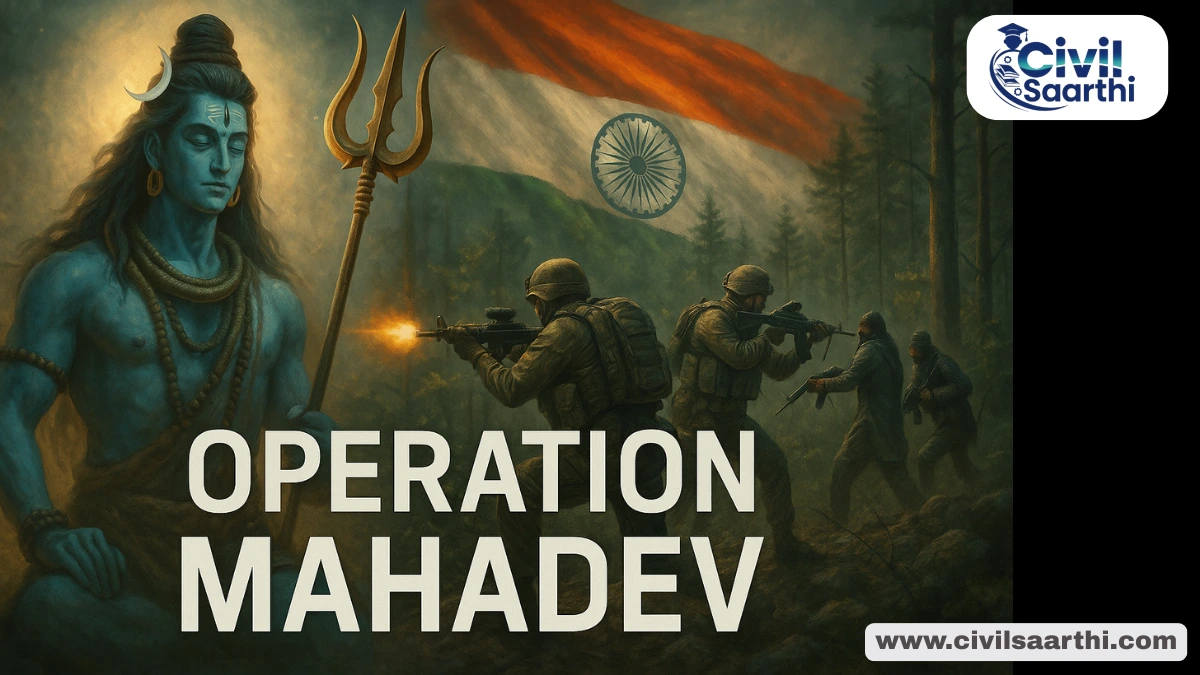Operation Mahadev was a high-profile counter-terrorism mission launched by Indian security forces on 28th July 2025 to neutralize the perpetrators of the Pahalgam massacre. The operation marked a significant victory in India’s fight against cross-border terrorism, demonstrating the country’s strategic depth and intelligence capabilities.
It took place in the forested ridge of Mount Mahadev, near Lidwas in Jammu and Kashmir, and led to the elimination of three heavily armed Pakistani terrorists.
What is Operation Mahadev?
Operation Mahadev was the Indian Army’s tactical response to the massacre. The operation was executed after 14 days of sustained intelligence and surveillance efforts. It was named after Mount Mahadev, which lies within the Zabarwan range outside Srinagar.
Significance of the Name:
Mount Mahadev is known for its rugged terrain and dense forest—a common infiltration route for militants.
- Symbolizes Hindu divine strength, adding symbolic weight to the mission.
Objectives of Operation Mahadev
The primary goal of the operation was to identify, track, and eliminate the core terror cell responsible for the Pahalgam attack.
Key Objectives:
Neutralize the mastermind behind the civilian massacre.
Break the operational chain of cross-border infiltration routes.
Disrupt any future plots against tourist or religious targets.
Demonstrate India’s zero-tolerance policy on terrorism.
Location of the Operation
The operation took place in the Lidwas–Harwan forest belt, near the Dachigam National Park in Jammu & Kashmir. This area is characterized by hilly slopes, pine forests, and limited civilian presence—ideal for terrorist hideouts.
Operation Mahadev Geography
| Feature | Description |
|---|---|
| Ridge/Area | Mount Mahadev / Zabarwan Range |
| Nearby Landmark | Dachigam National Park |
| Operation Zone | Lidwas–Harwan Forest |
| Distance from Srinagar | ~25 to 40 km |
| Terrain | Mountainous, dense forest cover |
Terrorists Killed in Operation Mahadev
The three terrorists killed were directly linked to the Pahalgam massacre. Among them was the main plotter and field commander.
Key Individuals:
| Name | Role in Pahalgam Attack | Origin |
|---|---|---|
| Suleiman Shah alias Hashim Musa | Mastermind, ex-Pak Army commando | Pakistan |
| Abu Hamza alias Harris | Shooter, coordinated fire positions | Pakistan |
| Yasir alias Ali/Jibran | Tactical aide, trained in explosives | Pakistan |
Impact on Counterterrorism and National Security
Long-Term Implications:
Heightened monitoring of infiltration routes in Zabarwan and Anantnag sectors.
Initiation of Operation Sindoor II for flushing out cross-border handlers.
Strategic shift to hybrid warfare readiness in forest belts.
Policy Effects:
Proposed increase in defense budget for J&K sector.
Review of tourist security protocols and drone surveillance integration.
Comparison with Past Counter-Terror Operations
The Mahadev Operation and other operations reflect India’s evolving counter-terror doctrine—from cross-border precision strikes to deep-penetration air raids, artillery-led bombardments, and terrain-specific internal missions. While the 2016 Surgical Strike and 2019 Balakot Air Strike focused on external punitive action, Operation Mahadev showcased India’s capability to track and neutralize high-value infiltrators within its own territory using real-time intelligence, inter-agency synergy, and terrain mastery. Together, these operations underscore a shift towards preemptive, technology-enabled, and politically decisive responses to terrorism.
| Operation | Year | Location | Target | Forces Involved | Outcome |
|---|---|---|---|---|---|
| Surgical Strike (LoC) | 2016 | LoC, PoK | Terror launch pads | Para SF | 38+ terrorists killed; camps destroyed |
| Balakot Air Strike | 2019 | Balakot, Pakistan | JeM training camp | Indian Air Force | 300+ estimated casualties; camp razed |
| Operation Sindoor | 2025 | LoC, PoK | Artillery and terror bunkers | Indian Army Artillery Corps | Multiple launch pads destroyed |
| Operation Mahadev | 2025 | Lidwas–Mahadev, J&K | Mastermind of Pahalgam massacre | 24 RR, 4 PARA, CRPF, J&K Police | 3 terrorists killed; advanced weapons seized |
Frequently Asked Questions (FAQs)
Q1. Who was behind the Pahalgam massacre?
A: Five terrorists linked to Lashkar-e-Taiba’s proxy TRF were responsible. The main planner was Suleiman Shah alias Hashim Musa.
Q2. Why was it called Operation Mahadev?
A: It was named after Mount Mahadev in the Zabarwan range, where the terrorists were hiding.
Q3. Which forces took part in the operation?
A: 24 Rashtriya Rifles, 4 PARA Special Forces, CRPF, and J&K Police.
Q4. What was recovered during the operation?
A: Advanced weaponry including an M4 carbine, AK rifles, grenades, satellite phones, and IED kits.
Q5. What makes Operation Mahadev significant?
A: It was a precise and swift retaliation to a major terror attack, highlighting India’s strategic capability.







